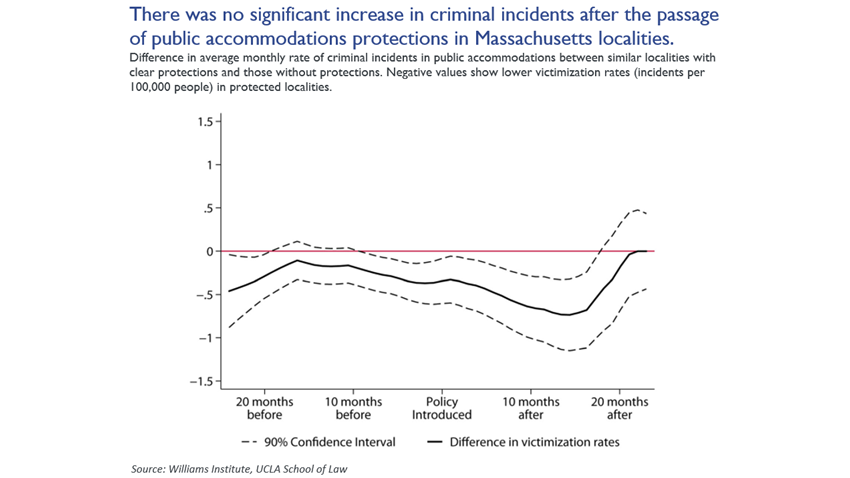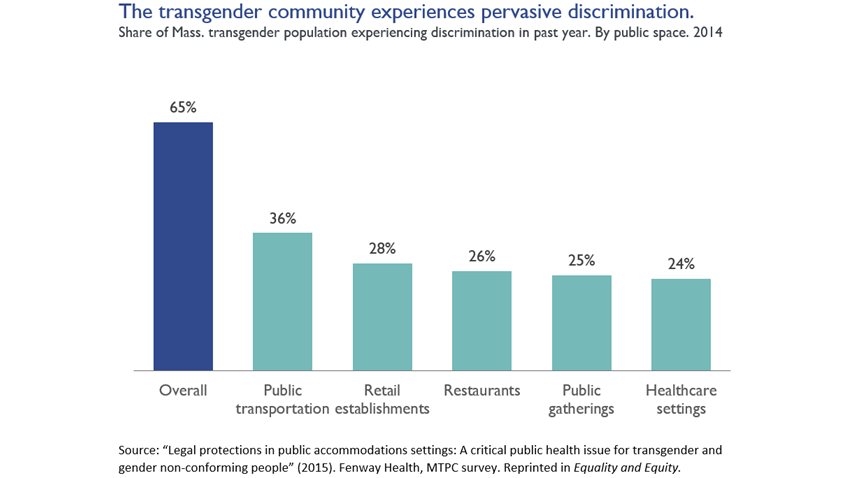Transgender Public Accommodations, by the Data
By Peter Ciurczak
November 1, 2018
As an increasingly diverse state, Massachusetts has taken some important steps to ensure that our friends, neighbors and co-workers feel welcome throughout our communities, especially when out in public. We’ve often led the way on anti-discrimination legislation. In 1946, more than 20 years before the passage of the Federal Fair Housing Act, Massachusetts began prohibiting discrimination in housing based on race, ancestry or religion. And in recent years, we’ve taken a couple of proactive steps to support inclusion of our state’s transgender residents.
Massachusetts passed a law in 2011 barring discrimination on the basis of gender identity for people purchasing homes, searching for work, applying for credit or attending college. What this law did not cover, however, was discrimination experienced by transgender people in public spaces. In a bipartisan effort to address this, the Legislature in 2016 passed an anti-discrimination law that added gender identity to the list of prohibited grounds for discrimination in public accommodations (such as hotels, restaurants and more). The law also requires public accommodations that have separate areas for males and females - such as restrooms - to allow full use of those areas in a way that’s consistent with the user’s sincerely held gender identity.
A vocal minority of Massachusetts citizens opposed this law, and placed a question on the ballot to vote “no” to end the current statutory protections related to public spaces. These proponents of “No on 3” claim that the protections granted in the 2016 law are being used by sex offenders to gain access to public restrooms and changing rooms.
What the data actually shows is this: Public accommodations protections do not lead to an increase in criminal incidents in these spaces. A September study from UCLA’s Williams Institute found that cities and towns in Massachusetts that passed public accommodations protections before 2016 saw no significant increase in criminal incidents. Further, where criminal incidents did occur, there is no evidence that these incidents involved people pretending to be transgender in order to harm others.
Instead, it is transgender people who experience significant victimization and discrimination. In Equality and Equity, a report released by Boston Indicators and the Fenway Institute back in May, we show that 65 percent of the commonwealth’s transgender population experiences some form of discrimination in public spaces.
It’s not just in these spaces that transgender people face discrimination. Despite 2011’s law protecting transgender people from housing discrimination, 61 percent of transgender people continue to have more difficulty attaining housing in Greater Boston as compared to their cisgender peers (Suffolk University Law School). Respondents to Suffolk’s study received higher rental quotes and fewer financial incentives to rent or purchase homes. Indeed, housing discrimination may contribute to the 8 percent of transgender people reporting homelessness in 2014, and the 24 percent reporting homelessness at some point over a lifetime.
Anti-discrimination laws alone are not going to end discrimination against transgender people – but they are important steps along the way. Adding gender identity to Massachusetts’ anti-discrimination laws in 2011 and 2016 gave the transgender community an avenue for redressing wrongs that was closed until very recently.
Further Reading: For more information about the LGBTQ population in and around Boston, including the transgender community, please check out the following:
- Equality and Equity: Advancing the LGBT Community in Massachusetts
- (Boston Indicators, Fenway Institute)
- Discrimination and Health in Massachusetts: A Statewide Survey of Transgender and Gender Nonconforming Adults
- (Fenway Institute, Life Skills, Massachusetts Transgender Political Coalition)
- 2015 U.S. Transgender Survey: Massachusetts State Report
- (National Center for Transgender Equality)
For more information about the transgender population nationally, please head to:
- 2015 U.S. Transgender Survey
- (National Center for Transgender Equality)


